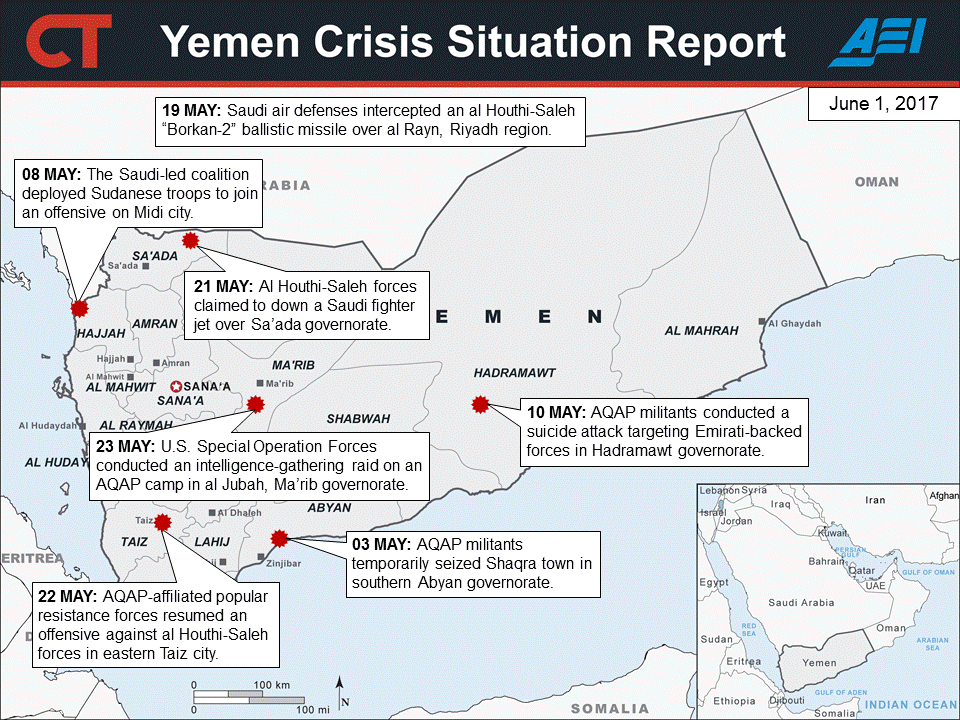UN-led efforts to negotiate a ceasefire in Yemen are unlikely to succeed. The al Houthi movement perceives these efforts to be closely tied to Saudi interests. They have also not advanced negotiations for a political resolution. The political stalemate creates an opportunity for Russia to position itself as a broker for peace in Yemen and undermine ongoing tracks to mediate the conflict.
The al Houthi movement’s and former Yemeni president Ali Abdullah Saleh’s divergent objectives in Yemen test their pragmatic partnership. The current situation empowers the al Houthi movement, particularly the inner circle, in northern Yemen, which incentivizes the al Houthis to preserve these conditions. The al Houthi demands for a negotiated ceasefire, such as the lifting of restrictions on Sana’a International Airport and the payment of public sector salaries from the Central Bank for personnel throughout the country, help to further establish the al Houthi position in Sana’a. Al Houthi representatives refused to meet with the UN Special Envoy to Yemen. Saleh began negotiating the terms for a political resolution that would secure his influence in Yemen during talks hosted by Russia.
U.S. special operations raids against al Qaeda in the Arabian Peninsula (AQAP) targets signal an increased military investment in Yemen but not a strategic-level shift in operations. U.S. Special Operation Forces (SOF) conducted an intelligence-gathering raid on an AQAP camp in Ma’rib governorate east of the Yemeni capital on May 23. It is the second acknowledged ground raid in Yemen. Both AQAP and local tribesmen denied an AQAP connection to the site of the raid in Ma’rib though AQAP militants were almost certainly present. AQAP militants have blurred the lines between themselves and Hadi government-allied popular resistance militias by participating in the anti-al Houthi fight in Ma’rib governorate.
AQAP’s propaganda advances al Qaeda’s global objectives and seeks to build local support in Yemen for its role in the civil war. AQAP emir Qasim al Raymi called on would-be recruits in the West to see themselves as part of the Muslim army and to rise up against the West in a May 7 video statement. Raymi focused on generating support among Yemenis in an April 30 interview in which he laid out AQAP’s argument for attacking Emirati-backed forces and the UAE and Saudi Arabia’s role as “agents” of the United States. Raymi cast the Yemeni civil war as part of the global war the Sunni community is fighting to defend itself, noting Muslims should unite against a common enemy. His phrasing implied disapproval of the position ISIS has taken, which instead divides the Muslim community. (Translations of AQAP statements obtained through SITE.)
The Yemeni state is fragmenting, reducing local support for the internationally recognized Hadi government. The Saudi-led coalition seeks to restore the Hadi government to power in Yemen, but the means by which the coalition has operated on the ground empowered local factions, some of which have ties to AQAP. Southern leaders broke from the Hadi government to establish the Transitional Political Council for the South, creating the possibility of a southern Yemeni polity. The president of the council, Aydarus al Zubaidi, met with Arab coalition members. Forces loyal to Zubaidi control Aden International Airport and serve as gatekeepers against Hadi government representatives entering Yemen. Members of the Hadi government returned recently to Yemen from Saudi Arabia. Separately, the coalition has not been able to mobilize enough Yemeni forces to fight offensively against the al Houthi-Saleh forces and instead shifted Sudanese troops from a force-protection mission in Aden to an offensive mission along the Red Sea coast.
U.S. President Donald Trump’s visit to Riyadh, Saudi Arabia, and meeting with Emirati Crown Prince Mohamed bin Zayed in Washington, DC, displayed U.S. support for Gulf partners. President Trump discussed the UAE-U.S. security partnership to counter Iran’s destabilizing activities and the al Qaeda and ISIS threats in the region on May 15. President Trump then met with counterparts in Riyadh and delivered remarks at the Arab Islamic American Summit. U.S. President Donald Trump concluded a $110 billion arms deal with Saudi Arabia during his visit, framing the package as part of a regional effort to counter Iranian interference. The Kingdom is under threat from al Houthi-Saleh cross-border attacks and ballistic missile strikes. The strong showing of U.S. support for Saudi Arabia and the Gulf States against Iran reflects the Trump administration’s priority effort to contain and reduce Iran’s influence in the region. Both Saudi Arabia and the UAE have asked the United States for additional support for their operations in Yemen.
There is unlikely to be a breakthrough in political negotiations that de-escalates the Yemeni civil war. Yemen is on course for increased factionalization and stalemated conflict. These conditions are exacerbating the humanitarian crisis in Yemen, which is likely to worsen. They also create opportunities for U.S. adversaries and enemies such as Iran, Russia, and al Qaeda to make gains on the ground.

